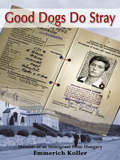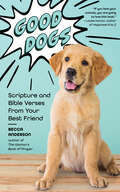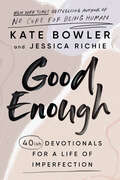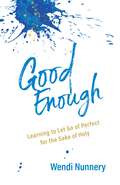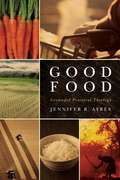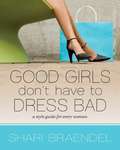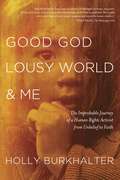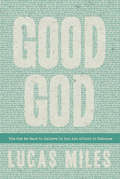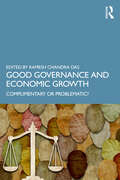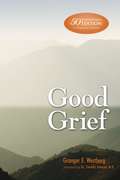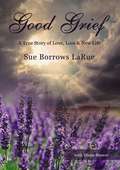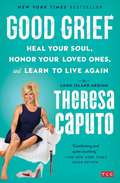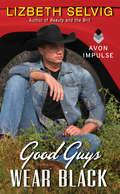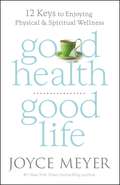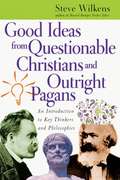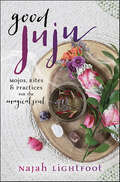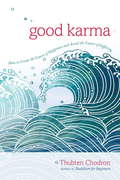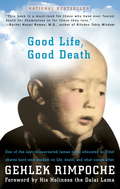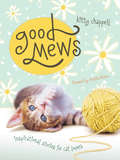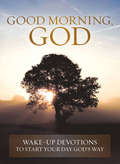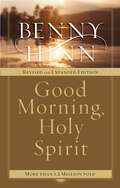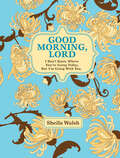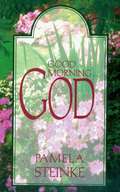- Table View
- List View
Good Dogs Do Stray: Memoir of an Immigrant from Hungary
by Emmerich KollerGood Dogs Do Stray is a poignant yet inspiring story about a poor country boy who escapes from Hungary with his family right after the failed Revolution in 1956. Koller provides a highly personal account of the hardships during WWII, in a Stalinist dictatorship, as a refugee and immigrant. The strong influences of a strict catholic upbringing, a simple village life, eight years in a traditional pre-Vatican II seminary as well as the political, social and religious events in the middle of the 20th century all contribute to the metamorphosis of a once naive country boy. Adversities in the formative years foreshadow an inauspicious future but faith and fate provide surprising reversals.
Good Dogs: Scripture and Bible Verses from Your Best Friend
by Becca AndersonAdorable dog photos paired with iconic Bible verses to warm your heart and give you guidance in times of need. Verses for Daily Meditation. This selection of inspiring, holy words will help you gain a greater understanding on subjects like faith, love, strength, peace, and knowledge. Becca Anderson, author of The Women&’s Book of Prayer and Prayers for Hard Times, knows you&’ll find the truth and hope you need guided by the Lord?and everyone&’s best friend in this Christian dog book.Good Dogs is the perfect Christian inspirational gift. In this book, you&’ll find: Thought-provoking verses for encouragement and meditationClarifying explanations on every pageBeautiful, heartwarming images of all your favorite dog breedsPerfect for readers of What&’s True about You, Zen Dogs, Color the Words of Jesus, or The Psalms in ColorPraise for Good Dogs&“If you love your animals, you are going to love this book. It will remind you that the bond we share with our pets is an expression of divine love.&” —Louise Hamon, author of Happiness A to Z
Good Enough: 40ish Devotionals for a Life of Imperfection
by Kate Bowler Jessica RichieA compassionate, intelligent, and wry series of Christian daily reflections on learning to live with imperfection in a culture of self-help that promotes endless progress, from the New York Times bestselling author of Everything Happens for a Reason and the executive producer of the Everything Happens podcast&“Brilliant, hilarious, absurd, honest, hopeful, true-hearted, and good to the core.&”—Sarah Bessey, editor of A Rhythm of Prayer and author of Jesus FeministIn Kate Bowler&’s bestselling memoir Everything Happens for a Reason, readers witnessed the ways she, as a divinity-school professor and young mother, reckoned with a Stage IV cancer diagnosis; in her follow-up memoir, No Cure for Being Human, she unflinchingly and winsomely unpacked the ways that life becomes both hard and beautiful when we abandon certainty and the illusion of control in our lives. Now, in their first-ever devotional book, Kate Bowler and co-author Jessica Richie offer 40ish short spiritual reflections on how we can make sense of life not as a pursuit of endless progress but as a chronic condition. This book is a companion for when you want to stop feeling guilty that you&’re not living your best life now.Written gently and with humor, Good Enough is permission for all those who need to hear that there are some things you can fix—and some things you can&’t. And it&’s okay that life isn&’t always better. In these gorgeously written reflections, Bowler and Richie offer fresh imagination for how truth, beauty, and meaning can be discovered amid the chaos of life. Their words celebrate kindness, honesty, and interdependence in a culture that rewards ruthless individualism and blind optimism. Ultimately, in these pages we can rest in the encouragement to strive for what is possible today—while recognizing that though we are finite, the life in front of us can be beautiful.
Good Enough: Learning to Let Go of Perfect for the Sake of Holy
by Wendi NunneryYou've checked all the boxes. You've followed all the rules. But something has still gone terribly wrong. This is where Wendi Nunnery—Jesus follower, college graduate, and newlywed—found herself eleven years ago. After years of meeting all the expectations set for a "good" Christian girl, she was suddenly spiraling into an unknown terror she would later discover was Obsessive-Compulsive Disorder and questioning everything she'd ever known about herself and about God. It took nearly a decade, but eventually Wendi learned her value was fixed. Finished. Holy. And it's in the pages of this book where she lays out the story of how and invites you to come along, find a friend, and realize you are not alone in your wandering. Driven by thoughtful, poignant essays with just the right amount of colorful language, Good Enough tackles the lie that we are required to be perfect in order to be good and, most importantly, reveals the truth about how much we've already been given.
Good Food: Grounded Practical Theology
by Jennifer R. AyresThis book equips readers with the theological and practical tools needed to safeguard that which sustains us: food.
Good Girls Don't Have to Dress Bad
by Shari BraendelIn Good Girls Don't Have to Dress Bad, Shari Braendel teaches you how to appreciate the body God gave you and how to always look your best--from conquering the battle of finding the right swimsuit, to choosing how many bangles you should wear or how big your purse should be, to wearing the right style jeans that will best flatter your thighs or hips, to finding the best places to shop to suit your unique personal style. Many of us are watching reality TV shows to get a clue on how to dress right and look good. We hungrily purchase fashion magazines any time the cover article has something to do with how we can hide our despised body parts. We make mad dashes to the local department store to pick up the new anti-wrinkle cream Oprah promised will take ten years away from our face. We care about how we look. Why is that? Because we're women, and women love to look and feel good. God made us that way. And this is not a bad thing. In fact, it's a wonderful thing. God loves beauty. He doesn't want us to reflect his image being sloppy, disheveled women of God who don't pay any attention to what we look like. Good Girls Don't Have to Dress Bad will show you how to look and feel your best, no matter what day it is or what the occasion. And it will also stop you from screaming at the top of your lungs, "I have nothing to wear. "
Good God, Lousy World, and Me: The Improbable Journey of a Human Rights Activist from Unbelief to Faith
by Holly Burkhalter"In this extraordinary memoir of grace, one of the foremost human rights advocates of the last half century shares her brutally and hilariously honest story of finding God on one of the most unlikely, irreverent, and utterly beautiful pilgrimages through life as it actually is." --Gary A. Haugen, president and CEO, International Justice Mission"It used to be that my own religious philosophy was to work hard, charm everyone within spittin' distance, and do a lot of crafts. So how did this hard-core leftist skeptic find peace and happiness among Bible-quoting, praying-out-loud, born-again evangelicals? I realized that my two choices--the existence of a loving God or the reality of evil--weren't the only options. Option three is that God is good and the world is lousy. But wait. There's more. God knows the world is lousy. Knows it, hates it, and wants us to do something about it..." --Holly Burkhalter, Good God, Lousy World & Me For over thirty years, Holly Burkhalter has worked as an international rights advocate for victims of genocide, rape, and injustice. Throughout most of her career, the heartbreak she encountered around the world--and in her own life--had convinced her that there was no such thing as a loving God. How could there be? If God was there, he should be charged as a war criminal for tolerating atrocities against the young, the poor, and the vulnerable. Then, Holly discovered a new truth: God was there--in the grief, in the violence, in the questions. And God was good. It was the greatest, hardest, most radiant surprise of her life. This is her story.From the Hardcover edition.
Good God: The One We Want to Believe In but Are Afraid to Embrace
by Lucas MilesIf we are honest, at some point we all struggle with the question, "Why does God allow pain, suffering, and evil?"
Good Governance and Economic Growth: Complimentary or Problematic?
by Ramesh Chandra DasGovernance has been incorporated into the development models of many countries because of its role in ameliorating inequalities in society. This book explores whether good governance boosts or hinders economic growth with perspectives from countries like India, the USA, Nigeria, Turkey, Pakistan, Bangladesh, Nepal, and others, and on groups of developing nations like BRICS and ASEAN.Governance has twin roles within economic systems. The first is where it guides administrators and the second is the normative role where it may act as a stimulus to economic growth and development. With the help of empirical investigations, this book analyses the interrelationships between good governance and inclusive and sustainable economic growth, productive employment, political stability, and decent work for all. It assesses the impact of various governance indicators and policy strategies on the economy and the GDP of countries in the Global North and South. The book also focuses on roadblocks to good governance such as violent conflicts, corruption, international threats and crises and its implication on economic growth. This volume will be of interest to students and researchers of economics, political science, social science, international relations, public administration, and sociology.
Good Grief
by Timothy Johnson Granger E. WestbergFor fifty years Good Grief has helped millions of readers find comfort and rediscover hope after loss. Today this classic text continues to offer helpful insights on the emotional and physical responses persons may experience during the natural process of grieving. Good Grief identifies ten stages of grief--shock, emotion, depression, physical distress, panic, guilt, anger, resistance, hope, and acceptance. However, recognizing that grief is complex and deeply personal and defines no "right" way to grieve, whether grieving the death of a loved one, the end of a marriage, the loss of a job, or other difficult life changes.
Good Grief: A True Story of Love, Loss and New Life
by Sue Borrows LaRueThis is an inspirational testimony of how God demonstrates His grace in human tragedy. Suzie Borrows battled for her husband&’s life, praying for a miracle. Hers is a story of love, loss and new life; a story of holding on to God&’s promises in faith; a story of talking to the Lord about everything and seeing Him answer prayer in unexpected and unimagined ways. This is the story of a woman laying her faith on the Word of God and believing Him for the literal truth of His Word; speaking His Word back to Him and humbly reminding Him of those promises. His answers to her heartfelt cries were provided through undeniable revelations which exceeded her dreams. Through His many mercies to Suzie, God&’s purpose gradually became her purpose.As human beings we may all enjoy blessings, such as family, health and prosperity, but we will also likely suffer loss, hardship and grief. Suzie&’s discovery of the ultimate power of God and His Word, along with her growing understanding of how much He truly loves us, transformed her life. Come along with her and experience the miraculous hand of God in the midst of her circumstances. He is no respecter of persons and wants you to know His love in a tangible way as well. Your faith will be ignited, just as Suzie&’s was as she walked hand in hand with the Lord.
Good Grief: Heal Your Soul, Honor Your Loved Ones, and Learn to Live Again
by Theresa CaputoNew York Times bestselling author Theresa Caputo, star of Long Island Medium and Raising Spirits provides a guide to overcoming grief, filled with inspiring lessons from Spirit and astonishing stories from the clients who have been empowered and healed by her spiritual readings.After more than a decade of being a practicing medium, Theresa Caputo shares the powerful lessons she has learned about grief, healing, and finding happiness in the wake of tragedy. In almost every reading she gives, Spirit insists that people begin to embrace their lives again. But not everyone knows where to start, and putting back together the pieces of a life marked by loss is never easy. Sometimes, you need spiritual guidance—and that&’s where Theresa comes in. With her energetic, positive, and encouraging tone, Theresa uses the lessons from Spirit to guide you through grief toward a place of solace and healing. Each lesson is grounded in her clients&’ experiences of losing loved ones, their encounters with Spirit during readings, and the ways in which they&’ve been able to heal and grow. Each chapter is filled with activities to help you find your &“new normal&”—including journaling, individual and group exercises, meditations, and moments of reflection—based on the truths that Theresa has gathered from Spirit. Good Grief—&“an excellent resource for those who wish to be in communication with deceased loved ones&” (Library Journal)—will help you to feel stronger and more optimistic about what the future has in store for you.
Good Guys Wear Black
by Lizbeth SelvigDewey Mitchell loves three things: fixing old cars, football, and family. Although an illness robbed him of his NFL dreams and his hopes for a big family of his own, he's made himself content working the family business and coaching middle school football. But when his town's vibrant new librarian and her young, emotionally challenged son burst into his ordered life, Dewey finds himself inexplicably drawn to the fascinating woman.Boston-born Rose Hanrehan had no idea how different living in a small town would be. But she's determined to start fresh for her son, who deals with Asperger's syndrome, without her overbearing parents judging her every move. Of course, sometimes her new neighbors seem to be equally closed-minded. And there's one new neighbor she can't seem to avoid ... in fact, the handsome Dewey, despite his black hat and buried emotions, might end up being the only reason to stay in Kennison Falls.Neither one is looking for love, but what they're starting to feel can't be anything else. Will the longtime bachelor and the free-spirited librarian let themselves fall? Or will their differences get in the way of their happy ending?
Good Health, Good Life: 12 Keys to Enjoying Physical and Spiritual Wellness
by Joyce MeyerMeeting the demands of your busy life may leave little time for you to focus on maintaining your personal well-being. But it is important to remember that each part of you-mind, body, and emotions-serves a purpose in God's exciting plan for your future. Embracing a healthier lifestyle will help you fully experience all the good things He has in store for you. Joyce Meyer, #1 New York Times bestselling author, understands that modern life is hectic and has created a practical plan for achieving good health, one day at a time. Her easy-to-use 12-Key Plan for Good Health will help you develop life-changing habits for a healthier lifestyle, no matter what your current level of health. By following her simple, yet effective tips on eating, exercise, rest, and stress management, you will unlock a new level of well-being, empowering you to live the fulfilling life you were meant to lead. Derived from material previously published in Look Great, Feel Great.
Good Housekeeping The Ultimate Kids Christmas Book
by The editors of Good HousekeepingHundreds of ways for kids 8 to 12 to celebrate Christmas including tree decorating, baking cookies and treats making fun & easy holiday crafts &‘Tis the season to bake, craft, and celebrate! This kid-approved big book of Christmas ideas was created by the editors and Test Kitchen chefs at Good Housekeeping and is filled with super fun projects, recipes and activities that will keep kids enchanted (and busy!) all season long. Three chapters highlight holiday essentials —celebrating (Plan a Christmas movie marathon!), crafting (Discover creative gift wrapping and make a gift for everyone on your list!), and dozens of simple sweets. (Cookies for Santa Claus? We&’ve got you covered!)Inside the ultimate holiday playbook for kids you'll find: Festive traditions from around the world to share with friends and family (Why do we decorate trees? What&’s the story behind St. Nick?)Super-fun activities (Plan a Christmas movie marathon! Make your own advent calendar! Go on a holiday scavenger hunt! Create a Christmas time capsule with the family! )Cute crafts you can make all on your own like DIY ornaments, garlands, and stockings.Recipes for yummy holiday treats—cookies, cakes, and of course, hot chocolate!This jam-packed book will keep you and your kids entertained this holiday and for many more to come.
Good Ideas from Questionable Christians and Outright Pagans: An Introduction to Key Thinkers and Philosophies
by Steve Wilkens"What indeed has Athens to do with Jerusalem? What concord is there between the Academy and the church?" (Tertullian, 3rd century). Such skepticism about the place of philosophy in the life of Christians persists down through the ages. As a student, author Steve Wilkens had deep reservations about studying the works of "pagans" or even "questionable Christians." Now a teacher at a Christian university, Wilkens has developed a deep appreciation for teaching and studying philosophy. In fact, he believes that the life of faith can be enriched by good philosophical reflection. In this book Wilkens helps you begin the same journey. Using generous quotations from the original sources, Wilkens provides an introduction to the study of philosophy by exploring a single key issue from each of the following philosophers: Socrates, Plato, Aristotle, Augustine, Aquinas, Descartes, Kierkegaard, Marx, Nietzsche and Sartre. The questions considered include: Why ask why? Is a just society possible? Is God responsible for evil? Can you be certain of anything? Is morality all about power? Do you really want to be free? Wilkens encourages you not to be a mere spectator but to actively and critically engage the questions and ideas these philosophers raise. Here is a book for beginning students, thoughtful Christians or anyone who wants to explore life's deepest questions.
Good Juju: Mojos, Rites & Practices for the Magical Soul
by Najah LightfootSpiritual Rites, Spell Work, and Folk Practices to Enhance Your Well-Being and Personal PowerLearn to better express your spirituality and build up your magical practice with this book's powerful spells, rituals, and tools. Designed to help you navigate whatever ups and downs life throws your way, Good Juju is your perfect choice for learning to embrace nature, the old ways, and the magick all around you.Using simple practices that don't interfere with any religions, Good Juju helps you lay a foundation for daily ritual work. You'll also learn how to craft mojos, create and work with altars, tune in to your intuition, and much more. Author Najah Lightfoot guides you in keeping your mind, body, and spirit strong as you discover your magical work and align with your higher power.
Good Karma: How to Create the Causes of Happiness and Avoid the Causes of Suffering
by Thubten Chodron"Lojong, or omind-trainingo is a practice that has gained astonishing popularly in recent years-because it works in transforming hearts and minds. Here is a presentation of lojong teachings that predates the oslogano practice with which people have become so familiar through the books of Pema Ch dr n and others, and that is every bit as powerful for imbuing the mind with intelligence and the heart with compassion. It is Thubten Chodron's commentary on a Tibetan poem with the imposing title oWheel of Sharp Weapons. o It is, as the title of this book indicates, an explanation of how karma works in our lives. But in explaining how to create good karma and avoid the negative effects of bad karma, it shows us how to live our lives with kindness and honesty-which makes things better not only for ourselves, but also for everyone else in the world. "
Good Life, Good Death
by Dalai Lama Rimpoche Nawang GehlekWho are we? Where did we come from? Where are we going? How do we get there? Many have asked these questions, and many have attempted to answer them. But there is another question Good Life, Good Death asks us to contemplate: how does the idea of life after death affect how we live our lives? Gelek Rimpoche tells stories of the mystical Tibet he lived in, as well as the contemporary America he is now a citizen of, and shares the wisdom of the great masters. He asks us to open our minds and see if we can entertain a bigger picture of life after life, even for a moment. He makes the connection between powerful emotions such as anger, obsession, jealousy and pride, and our past as well as our future.
Good Mews
by Kitty ChappellMove over dog lovers, "man" is getting inspurrrration from a new best friend-cats! God placed cats on earth with a special mission-to provide unconditional God-like love and support to their owners. In Good Mews, Kitty Chappell captures the playful and inquisitive characteristics we all love about the feline species, and she turns everyday occurrences into a practical life application. Her uplifting stories parallel real life circumstances in the overall scheme of God's view, ending with a scripture tie-in. It's a simple and fun approach to understanding ourselves and God a little better, and maybe even our cats, too! Foreword by Martha Bolton, who's written comedy for performers such as Bob Hope, Phyllis Diller, and Mark Lowry. A great book for devotions! There are 35 million cat owners in the United States. Millions of these cat owners love their special pets enough to celebrate special days with them. More than 13 million cats receive birthday celebrations, and more than 37 million cats get Christmas gifts!
Good Morning, God
by David C CookBeginning your day with God can really make the day rich and meaningful, not to mention successful in ways you never dreamed possible. The time you sow in the morning is a precious seed that brings forth a beautiful day filled with strength, joy, and a love made sweeter because it begins with the One who loves you best.Good Morning, God is a wonderful morning devotional filled with inspiring scriptures, true-to-life stories, and encouraging reflections to help you fulfill the promise of each new day that your loving heavenly Father has given you to enjoy.
Good Morning, Holy Spirit: Learn to Recognize the Voice of the Spirit
by Benny Hinn20th anniversary of this classic with more than one million copies sold. Revised and updated with bonus study guide included. One cold winter night in Toronto, the Holy Spirit entered Benny Hinn's life in such a dramatic way that he was changed forever. The same thing can happen to you. Join the millions of others who have read Good Morning Holy Spirit and discover if you are ready to meet the Holy Spirit intimately and personally, willing to listen to His voice, and prepared to know Him as a person.In this revised and expanded edition of Good Morning, Holy Spirit, Benny Hinn shares the insights and the truths that God has taught him through the years. Good Morning, Holy Spirit provides the principles needed to gain a better understanding of the Godhead while you discoverhow to recognize the voice of the Spiritseven steps to a more effective prayer lifethe source and purpose of God's anointingfreedom from fear of the "unpardonable" sinGod's master plan for youGood Morning, Holy Spirit also is available in Spanish, Buenos Días, Espiritu Santo
Good Morning, Little One: New Mercies and Prayers to Carry You Through the Day
by Amy KavelarisReassure kids that God is carrying them throughout the day with these morning affirmations and whimsical illustrations from beloved author Amy Kavelaris. Adorable animals with gorgeous floral art and words of hope remind little ones of God's love, security, and peace for the day ahead.Through a child&’s eyes, the world can be beautiful, wonder-filled, and a bit fear-filled all at the same time. Remind your little one that God is always near with this unique book of blessings. A beautiful companion to Amy Kavelaris&’s popular Good Night, My Darling Dear, this inspirational picture bookreassures children ages 4 to 8 that God carries them through good days, hard days, and anxious daysshares biblical promises of God's love, purpose, and protectionfeatures the whimsical imagery of nature and animals that has made Kavelaris&’s art belovedencourages kids to discover God each day and joyfully live out who He created them to begives children confidence to be brave in scary and unexpected situationsThis unique book of blessings and prayers will remind your little one of God&’s loving promises revealed in nature: that He protects us from the rain, He covers us with His wings, He shines His light into the darkness, and most of all, He&’ll always be with us. Good Morning, Little One by artist Amy Kavelarisincludes a stunning cover with a jacket over hardcovermakes a touching keepsake gift book for a child's Easter basket, baby showers, and other new beginnings such as adoption, a new sibling, or the first day of schoolis an enchanting piece of art for a botanical nursery or child's bedroomis ideal for any parent, grandparent, or family who wants to establish a tradition of blessing their child in the morningThere's no better way to start the day than praying over your children with this sweet, Scripture-based book about trusting God to carry each of you in His gentle arms.
Good Morning, Lord: I Don't Know Where You're Going Today, But I'm Going With You
by Sheila WalshDelight in each day as an adventure in trusting a faithful God. Whether facing day-to-day frustrations or long-term struggles with fear, insecurity, or the weight of a painful past, Sheila Walsh takes women by the hand and helps build unbridled trust in The One who gives hope, healing, peace, and redemption. Each ‘day’ starts with a devotion geared toward real life situations that women often face, and ends with questions for thought and space for journaling personal reflections. The invitation is to journey through lessons that women can use immediately to establish a deep, life-altering trust in the Father.
Good Morning...God
by Pamela Steinke"Good Morning... God!" is a daily devotional encounter with Christ. A book to be read again and again, dog-eared, under-lined, and treasured. It speaks to the deepest needs of the heart ofmankind in a refreshingly unique manner. This collection of treasures from the heart of God, was recorded by an ordinary person who cared to "listen". These daily messages lifted her from fear to trust, from depression to joy, from anxiety to peace. They can do the same for you. "Good Morning... God!" is not just a book - it is an experience! "Taste and see that the Lord IS good!"
